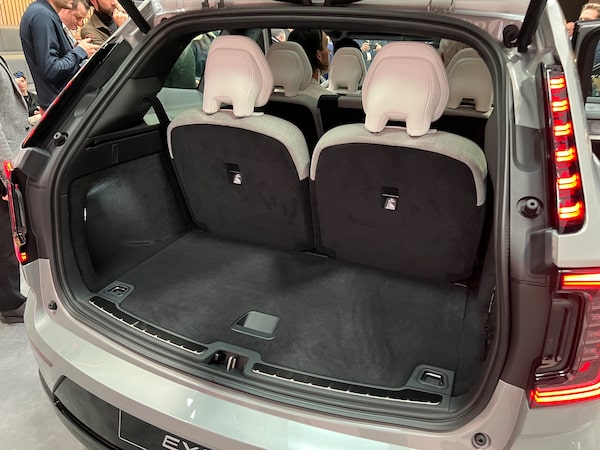
Volvo revealed its all-electric, three-row SUV, the EX90, in Stockholm on Nov. 9.Jason Tchir/The Globe and Mail
Volvo revealed the EX90 in Stockholm this week, the first in a new lineup of electric vehicles for the Swedish car maker, which has a goal of only selling all-electric vehicles by 2030.
The seven-seat flagship SUV with a range of up to 500 kilometres, is expected to arrive in Canada in early 2024. Pricing for Canada wasn’t announced, but we would expect it to be in the same ballpark as its Polestar 3 platform sibling at around $100,000.
To hit the 2030 goal, Volvo plans to release one new all-electric car every year. Jim Rowan, Volvo’s chief executive officer, teased at the event that another SUV might be next, but Volvo stayed quiet on any details.
“I often get asked: ‘Will the market move toward full electric that quickly?’” Rowan said. “My answer isn’t just ‘yes,’ but a resounding ‘yes.’”
The EX90 has a 111-kilowatt-hour battery that can charge from 10 to 80 per cent in 30 minutes at a 250-kilowatt DC fast charger, lidar that can see hazards 250 metres away in the dark and the capability for bidirectional charging, which means the car could power your house.

The EX90 will have a range of up to 500 kilometres and is expected to arrive in Canada in early 2024.Jason Tchir/The Globe and Mail
Set to be built in Charleston, N.C. – with plans to later also start building in China – and built on the same platform as the Polestar 3, the EX90 is Volvo’s first three-row all-electric SUV.
When the EX90 arrives in Canada, it will be Volvo’s third all-electric vehicle – after the Volvo XC40 Recharge (an EV version of the gas-powered XC40) and the C40. They’re both compact SUVs.
Like all future Volvo EVs, the EX90 was designed and built as an all-electric car – there will be no gas-powered or hybrid version.
It’s being released first as a 408-horsepower all-wheel-drive version with dual motors powering the front and rear wheels. There will be a 517-horsepower performance version. Volvo didn’t say which version we’ll get in Canada.
Promises of future tech?
Unlike some EV SUVs, the EX90′s looks aren’t startling – although the bump above the windshield that hides the lidar takes a little getting used to.
Although it’s designed to be aerodynamic, it doesn’t have odd angles or big spoilers. Instead, it has smooth, clean lines. Because EVs don’t need vents in the front grille, Volvo designed a seamless front end, which is sharp, if a little bland – but clearly a Volvo.
The interior is clean and simple. Wood inserts on the dash look solid by day, but light up with an LED pattern at night. The interior is leather-free. Instead, Volvo uses wool in the upholstery.

Like previous Volvos, the car features a large centre screen that accepts 'Hey, Google' voice commands.Jason Tchir/The Globe and Mail
The first two rows are roomy but the third row is tight for two adults – which is the norm for most three-row SUVs.
Like previous Volvos, it features a large centre screen that accepts “Hey, Google” voice commands.
Eventually, it will be able to sync with a Google Home device in your house, so, for instance, you can ask Google about your car’s charging level or tell it to warm your car from your kitchen.
The interface is designed to give drivers the information they need and nothing more to minimize distraction, Volvo said.
Other tech includes a 5G connection that will let the car accept over-the-air software updates, the same way a smartphone does, and the ability to unlock and start the car using your phone as the key. There will be wireless Apple CarPlay and Android Auto.
It has the hardware to be capable of bidirectional charging, which will let the Volvo charge another car or send power to the grid. It also has the capability to automatically start charging as soon as you plug in a fast charger and to just bill your account – similar to how Tesla Superchargers work – instead of making you fumble through apps to pay before you can start charging. Right now, the feature is not available in any Canadian cities.
Volvo said these features will be rolled out through software updates as they become available, although it’s not known when that will be.
Safety first?
Safety-wise, Volvo said radars, cameras and lidar should help drivers avoid dangers on the road – its research shows that lidar could help prevent one out of every 10 crashes and prevent serious injuries in one out of every five.
Inside, the car will watch drivers to make sure they’re focused on the road. If they’re not, the car will warn them – eventually, it will be able to pull over on its own. It will also sense anyone left inside the car.
On top of style and safety, Volvo touted sustainability.

Volvo said it will aim to build cars with 25 per cent recycled steel and plastic and 40 per cent recycled aluminum.Jason Tchir/The Globe and Mail
The EX90 also contains about 15 per cent recycled steel, 25 per cent recycled aluminum and 15 per cent recycled plastic. By 2025, the company said it will aim to build cars with 25 per cent recycled steel and plastic and 40 per cent recycled aluminum.
“We’ve burned our bridges,” said Bjorn Annwall, Volvo’s deputy chief executive officer, about the fast change to electric. “There’s no going back.”
The writer was a guest of the automaker. Content was not subject to approval.
Shopping for a new car? Check out the new Globe Drive Build and Price Tool to see the latest discounts, rebates and rates on new cars, trucks and SUVs. Click here to get your price.
 Jason Tchir
Jason Tchir